Rotary Jail Museum
Rotary Jail Museum

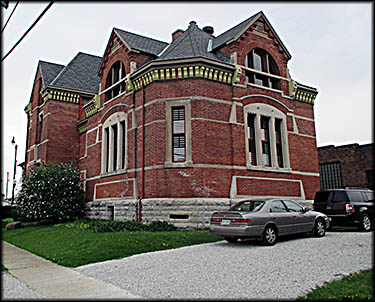
Rotary Jail Exterior. The section
here is where the sheriff lived.
here is where the sheriff lived.
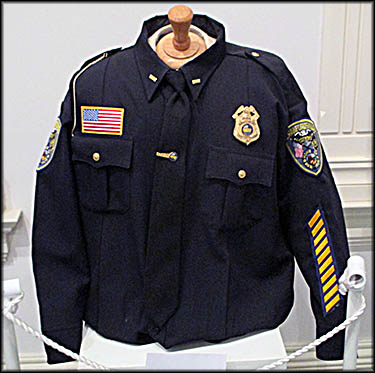
Sheriff’s Shirt
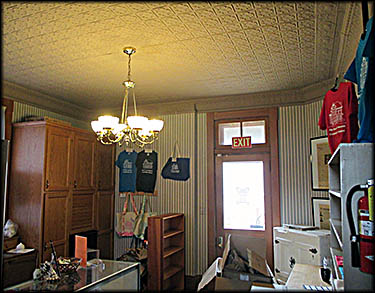
What was once the
kitchen is now a giftshop.
kitchen is now a giftshop.
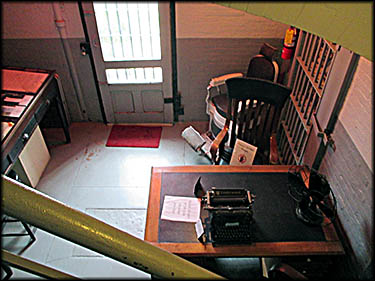
Sheriff’s Office
The Rotary Jail Museum in Crawfordsville, Indiana, proudly advertises that it is the oldest of its type in the United States and the only one that still works. While this might elicit excitement from experts on the topic of incarceration, it just baffled me. I’d never heard of such a thing. I had envisioned the entire building rotating, the purpose for which I couldn’t fathom. Naturally I had to investigate. Unlike what I’d imagined, the whole structure doesn’t spin. Rather, it has a circular cellblock turned by a hand crank surrounded by an unmoving set of thick bars with a single entrance. Prisoners could only enter or leave only if their cell were aligned with the door, preventing escape by jimmying the lock.
Indiana’s Montgomery County decided to have one of these built both to the ensure that prisoners were secured and to cut down on the manpower it took to guard them. Just two sentinels watched the inmates, each taking a twelve hour shift. The building was half house, half jail, the former being where the sheriff lived. The latter was designed by two Indianapolis men—William H. Brown, an architect, and Benjamin F. Haugh, owner of an iron foundry—who patented their invention. (You can see a copy of this as well as photos of the basement—which wasn’t open to the public during my visit—here.) The first of its kind when it opened in 1882, the rotating jail design never really took off. Only eighteen were every built. The Pauly Jail Building and Manufacturing Co. of Missouri soon acquired the patent because it didn’t particularly like rotary jails and wanted the design squashed, though it did offer one in its Illustrated Descriptive Catalog of Steel Jail Cells and Other Iron Work for County Jails and Other Prisons.
Indiana’s Montgomery County decided to have one of these built both to the ensure that prisoners were secured and to cut down on the manpower it took to guard them. Just two sentinels watched the inmates, each taking a twelve hour shift. The building was half house, half jail, the former being where the sheriff lived. The latter was designed by two Indianapolis men—William H. Brown, an architect, and Benjamin F. Haugh, owner of an iron foundry—who patented their invention. (You can see a copy of this as well as photos of the basement—which wasn’t open to the public during my visit—here.) The first of its kind when it opened in 1882, the rotating jail design never really took off. Only eighteen were every built. The Pauly Jail Building and Manufacturing Co. of Missouri soon acquired the patent because it didn’t particularly like rotary jails and wanted the design squashed, though it did offer one in its Illustrated Descriptive Catalog of Steel Jail Cells and Other Iron Work for County Jails and Other Prisons.

The cellblock had two tiers, each containing eight cells in the shape of pie pieces. On the floor above the top tier was the infirmary, and below the bottom tier the basement. There were two small rectangular cells on the second floor, one used for maximum security the other for female prisoners. Though rare in 1882, all the cells had indoor plumbing. The jail and house were also set up to use either gas or electric. Heat came from a steam system. The sheriff had an office next to the cellblock on the first floor. The last sheriff to live in the house and oversee the jail had a bit of a problem when it came to feeding his prisoners: the food, cooked by his wife, was too good, causing citizens to purposely get arrested so they could have a great meal and a nice warm place in which to sleep overnight.
Not surprisingly, this jail design had considerable flaws. For one, if a prisoner didn’t pull his hands inside the cell when it moved, he might lose them. This sometimes happened to drunks staying for the night, so a separate cell independent from the rotating ones was built as a drunk tank. One repeat offender had a peg leg that he purposely put it through the bars when the cellblock spun to break it because then county would buy him a new one. Needless to say, after a few times of this, the sheriff confiscated said appendage during this man’s subsequent stays.
Another problem was fire. It took a considerable amount of time to rotate and release prisoners, as one who started and died in a fire discovered. The cells also had poor ventilation and received little natural light. To comply with fire safety codes, each cell was given its own door, ending the need for spinning the cellblock.
Not surprisingly, this jail design had considerable flaws. For one, if a prisoner didn’t pull his hands inside the cell when it moved, he might lose them. This sometimes happened to drunks staying for the night, so a separate cell independent from the rotating ones was built as a drunk tank. One repeat offender had a peg leg that he purposely put it through the bars when the cellblock spun to break it because then county would buy him a new one. Needless to say, after a few times of this, the sheriff confiscated said appendage during this man’s subsequent stays.
Another problem was fire. It took a considerable amount of time to rotate and release prisoners, as one who started and died in a fire discovered. The cells also had poor ventilation and received little natural light. To comply with fire safety codes, each cell was given its own door, ending the need for spinning the cellblock.
It is probably at this point the aforementioned maximum security cell was introduced. As the twentieth century moved on and building safety became the law of the land, inspectors repeatedly condemned the jail. In 1967, a grand jury assembled to investigate this possibility ordered its abandonment, though the facility didn’t close until 1973. By then considered an eyesore, some wanted to tear it down, but another realized it would make an excellent museum, which it became in 1975. In that year it was also listed on the National Registry of Historic Places.
Something also occurred here that I had not expected: executions carried out by the county. I always thought this type of punishment was reserved exclusively for states and the federal government, but in the nineteenth century this was not the case. Capital punishment in that era was often a gruesome public spectacle. I’ve heard many an adult who has reached middle age and beyond rue against the terrible violence on television children are exposed to. Well, that sort of thing wasn’t just acceptable in the nineteenth century, it was encouraged. The idea being that if you children witnessed a hanging, they would be more apt to behave knowing what could happen if they didn’t. More likely it led to a surge in nightmares.
Something also occurred here that I had not expected: executions carried out by the county. I always thought this type of punishment was reserved exclusively for states and the federal government, but in the nineteenth century this was not the case. Capital punishment in that era was often a gruesome public spectacle. I’ve heard many an adult who has reached middle age and beyond rue against the terrible violence on television children are exposed to. Well, that sort of thing wasn’t just acceptable in the nineteenth century, it was encouraged. The idea being that if you children witnessed a hanging, they would be more apt to behave knowing what could happen if they didn’t. More likely it led to a surge in nightmares.
Executions could also be profitable. A barber from nearby Waverly noted in his diary that he “sold 45 papers on the strength of the execution” of John W. Coffee, who had murdered James McMullen and his wife in their house near the village of Elmdale in early January 1885. Coffee had at the time lived about half a mile away and worked for the couple. On the night of the deed, he arrived at their house at 7 p.m. and engaged in a normal conversation. For reasons not reported in the St. Louis Globe-Democrat from which the information about this crime comes, as Mrs. McMullen prepared for bed, Coffee “struck Mr. McMullen twice on the head with a stick of stove-wood,” killing him. Mrs. Mullen begged for her life, offering Coffee all the money she had, a mere 25 cents. Mercy did not prevail. “He beat her to death with a stick of wood.” Captured on January 11, 1885, he hanged on October 16, 1885, at nine in the morning.
His execution was quite memorable. Performed in an enclosed area, only 200 guests invited by the sheriff were allowed to watch. Coffee, who refused to eat or drink the night before, he had a “spasm” shortly before going to the scaffold and was therefore “half-carried to” it. Incoherent the moment the rope went around his neck, he tried to implicate others. The trapdoor dropped. Gravity did its job but the rope didn’t: it broke. Blood oozed from his ears. Up he went again, this time begging to have his mask taken off so he could make a speech. Refused, he dropped again. The second rope proved no more durable than the first, though someone below caught Coffee before he hit the ground. A new rope was found, and, unlike the previous two, it was not tested first. It did not snap, nor did Coffee’s neck, causing him to suffer for twelve agonizing minutes before he suffocated to death. One contemporary article ended with this understatement: “The spectacle was sickening.”🕜
His execution was quite memorable. Performed in an enclosed area, only 200 guests invited by the sheriff were allowed to watch. Coffee, who refused to eat or drink the night before, he had a “spasm” shortly before going to the scaffold and was therefore “half-carried to” it. Incoherent the moment the rope went around his neck, he tried to implicate others. The trapdoor dropped. Gravity did its job but the rope didn’t: it broke. Blood oozed from his ears. Up he went again, this time begging to have his mask taken off so he could make a speech. Refused, he dropped again. The second rope proved no more durable than the first, though someone below caught Coffee before he hit the ground. A new rope was found, and, unlike the previous two, it was not tested first. It did not snap, nor did Coffee’s neck, causing him to suffer for twelve agonizing minutes before he suffocated to death. One contemporary article ended with this understatement: “The spectacle was sickening.”🕜
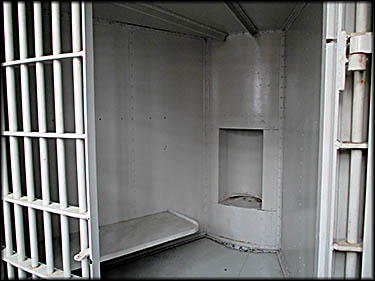
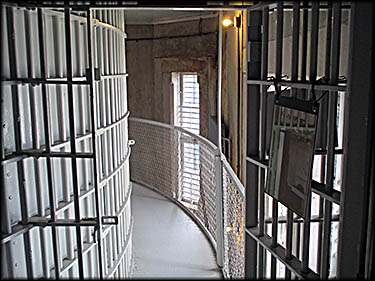
Jail Cells
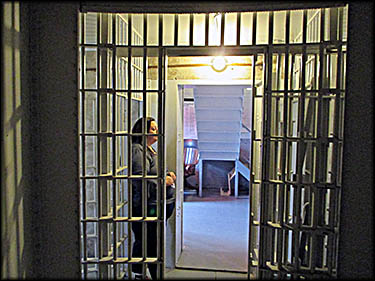
The Way Out
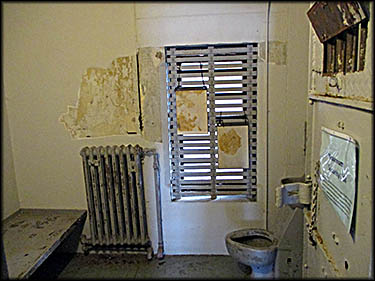
Maximum Security Cell